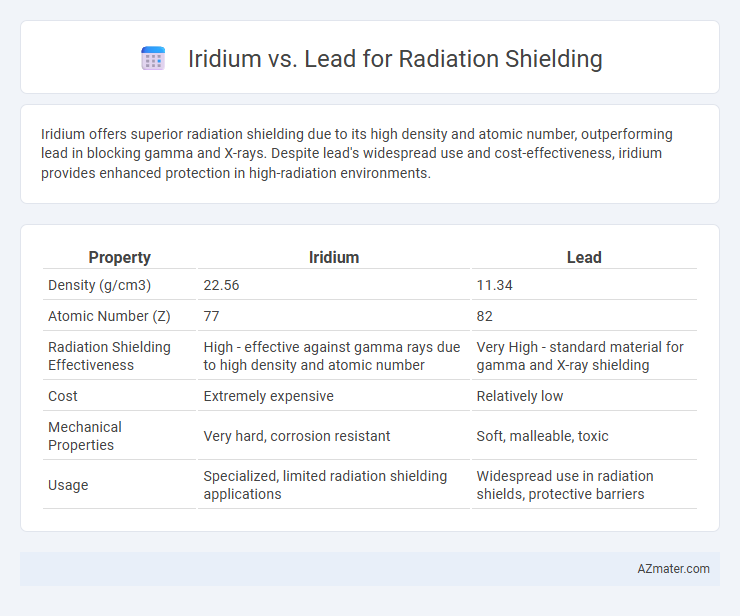Iridium offers superior radiation shielding due to its high density and atomic number, outperforming lead in blocking gamma and X-rays. Despite lead's widespread use and cost-effectiveness, iridium provides enhanced protection in high-radiation environments.
Table of Comparison
| Property | Iridium | Lead |
|---|---|---|
| Density (g/cm3) | 22.56 | 11.34 |
| Atomic Number (Z) | 77 | 82 |
| Radiation Shielding Effectiveness | High - effective against gamma rays due to high density and atomic number | Very High - standard material for gamma and X-ray shielding |
| Cost | Extremely expensive | Relatively low |
| Mechanical Properties | Very hard, corrosion resistant | Soft, malleable, toxic |
| Usage | Specialized, limited radiation shielding applications | Widespread use in radiation shields, protective barriers |
Introduction to Radiation Shielding Materials
Iridium and lead are widely studied materials for radiation shielding due to their high atomic numbers, which enable effective attenuation of ionizing radiation such as gamma rays and X-rays. Lead, known for its density of 11.34 g/cm3 and affordability, provides efficient shielding in medical and industrial applications, while iridium, with a density of 22.56 g/cm3 and exceptional corrosion resistance, offers superior durability in extreme environments. The choice between iridium and lead depends on factors such as shielding effectiveness, weight constraints, chemical stability, and cost considerations in specific radiation protection scenarios.
Properties of Iridium for Radiation Shielding
Iridium exhibits exceptional density and atomic number, making it highly effective for absorbing high-energy radiation such as gamma rays and X-rays compared to lead. Its superior melting point (2446 degC) and corrosion resistance ensure durability in harsh environments where radiation shielding is required. The high atomic mass and compact crystalline structure of iridium contribute to its superior attenuation properties, providing more efficient radiation protection in compact, lightweight applications.
Properties of Lead for Radiation Shielding
Lead is a dense metal with a high atomic number (82), making it highly effective at attenuating gamma rays and X-rays through photoelectric absorption and Compton scattering. Its malleability allows it to be easily shaped into protective barriers, while its relative affordability and availability contribute to widespread use in medical, industrial, and nuclear radiation shielding applications. Lead's ability to absorb and scatter ionizing radiation reduces exposure risks, providing reliable protection in environments with high radiation levels.
Density Comparison: Iridium vs Lead
Iridium has a density of approximately 22.56 g/cm3, making it one of the densest naturally occurring elements, while lead's density is about 11.34 g/cm3, nearly half that of iridium. The higher density of iridium enhances its effectiveness in radiation shielding by providing greater mass per unit volume to absorb and attenuate radiation. Despite lead's widespread use due to its cost-effectiveness, iridium's superior density offers improved protection in environments requiring compact and highly efficient radiation shields.
Radiation Attenuation Effectiveness
Iridium offers superior radiation attenuation effectiveness compared to lead due to its higher atomic number (77 vs. 82) and greater density (22.56 g/cm3 vs. 11.34 g/cm3), enabling more efficient absorption of gamma rays and X-rays. The high electron density in iridium enhances Compton scattering and photoelectric absorption, significantly reducing radiation penetration in compact shielding applications. Despite lead's widespread use for cost efficiency, iridium's exceptional attenuation properties make it ideal for specialized environments requiring maximum protection with minimal thickness.
Durability and Longevity Under Radiation Exposure
Iridium exhibits superior durability and longevity under intense radiation exposure due to its high atomic number and exceptional resistance to radiation-induced damage, making it more effective for long-term radiation shielding compared to lead. Lead, while commonly used for radiation shielding because of its density and cost-effectiveness, tends to degrade and become brittle over prolonged exposure to high radiation levels, limiting its service life. The superior structural integrity of iridium alloys under sustained radiation enhances shielding performance and reduces maintenance or replacement needs in nuclear reactors and space applications.
Safety and Toxicity Concerns
Iridium offers superior radiation shielding efficiency due to its high atomic number and density, allowing for thinner protective barriers compared to lead. Lead, while effective and widely used in radiation protection, poses significant toxicity risks including lead poisoning and environmental contamination from heavy metal exposure. Safety protocols in radiation shielding favor iridium in applications demanding minimal toxicity, although cost and material availability remain critical factors in material selection.
Cost and Availability Analysis
Iridium offers superior radiation shielding due to its high density and atomic number but is significantly more expensive and scarce compared to lead, limiting its practical application. Lead remains the most cost-effective and readily available material for radiation shielding, making it the preferred choice in medical, industrial, and nuclear environments. Despite lead's lower performance against certain radiation types, its affordability and widespread availability outweigh the cost-prohibitive nature and limited supply of iridium.
Practical Applications in Industry and Medicine
Iridium and lead differ significantly in radiation shielding due to iridium's higher density (22.56 g/cm3) compared to lead's 11.34 g/cm3, making iridium more effective for shielding high-energy gamma rays in compact medical devices such as brachytherapy sources. Lead remains the industry standard for large-scale radiation shielding in nuclear power plants and radiology facilities because of its cost-efficiency and ease of fabrication into protective barriers and aprons. In specialized applications requiring miniaturized or high-performance shielding, iridium alloys offer enhanced durability and radiation attenuation but are limited by higher material costs and machining complexity.
Summary and Material Selection Guidelines
Iridium offers superior radiation shielding due to its high atomic number (Z=77) and dense atomic structure, effectively attenuating gamma and X-ray radiation compared to lead (Z=82). Lead remains widely used for cost-effective shielding in medical and industrial applications, but iridium's enhanced durability and higher melting point make it preferable for extreme environments and long-term use. Material selection should consider factors such as radiation type, intended exposure duration, mechanical strength, and budget constraints, balancing iridium's performance advantages against lead's economic feasibility.

Infographic: Iridium vs Lead for Radiation Shielding
 azmater.com
azmater.com